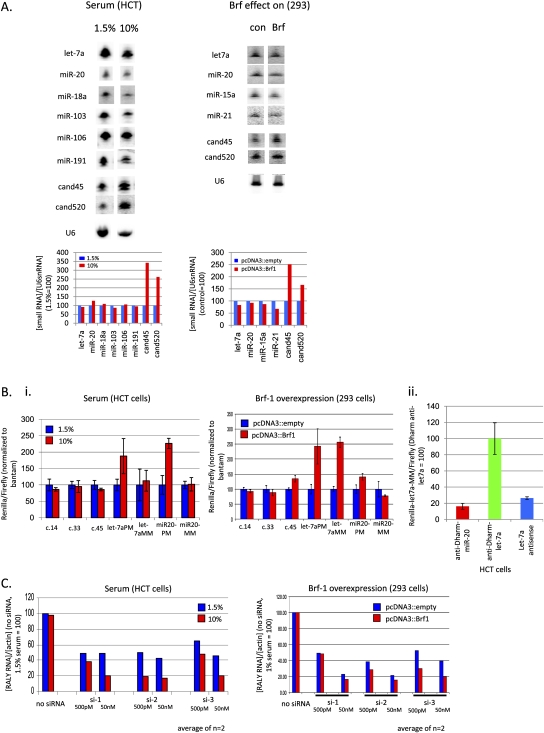FIGURE 8.
Increased tsRNA abundance correlates with reduction and increase in microRNA and siRNA efficacies, respectively. (A) tsRNA abundance can be modulated by varying serum concentrations or overexpressing the tRNA transcription factor Brf1 (Northern blot; corresponding U6snRNA-normalized phosphorimage quantitations shown below). Blots were stripped and rehybridized. Total RNA from 293 cells was harvested on day 4 after Brf1 transfections on days 0 and 2. For the serum experiments, HCT116 cells cultured for 5 d under 1.5% or 10% serum were chosen. (B, i) MicroRNA silencing capacity is reduced in the presence of increased tsRNA abundance (dual luciferase assay). The target sites of the Renilla luciferase reporters are indicated with “c.14” (cand14) on the X-axis; PM/MM: perfect match/translational reporters. Results are normalized to the Renilla/Firefly ratios of reporter plasmid with no predicted small RNA target site (“bantam”), with 1.5% serum and control pcDNA3∷empty set at 100 for each reporter. (B, ii) Silencing efficiency of translational psi-let-7aMM reporter as indicated by let-7a inhibition (dual luciferase assay). anti-Dharm miR-20: control microRNA hairpin inhibitor; anti-Dharm let7a: let7a hairpin inhibitor; let-7a antisense inhibitor. “anti-Dharm let-7a” where most apparent let-7a inhibition was observed was set = 100. (C) SiRNA silencing is improved in the presence of increased tsRNA abundance (real-time qRT-PCR). Three different siRNAs (si-1–si-3) targeting endogenously expressed RALY RNA were transfected at two concentrations, 500 pM and 50 nM and remaining RALY RNA levels normalized to actin measured.

